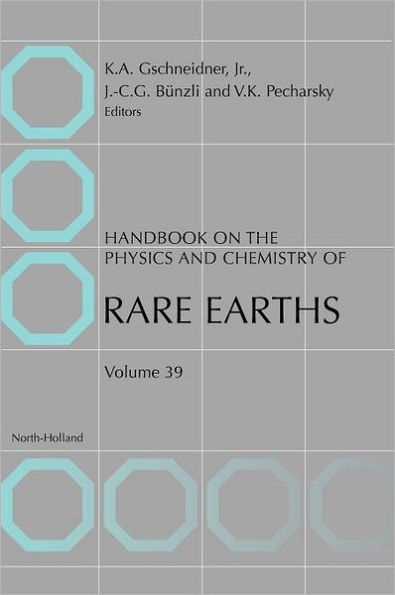Handbook on the Physics and Chemistry of Rare Earths available in Hardcover, eBook

Handbook on the Physics and Chemistry of Rare Earths
- ISBN-10:
- 0444521437
- ISBN-13:
- 9780444521439
- Pub. Date:
- 03/10/2008
- Publisher:
- Elsevier Science
- ISBN-10:
- 0444521437
- ISBN-13:
- 9780444521439
- Pub. Date:
- 03/10/2008
- Publisher:
- Elsevier Science

Handbook on the Physics and Chemistry of Rare Earths
Buy New
$350.00Overview
The first chapter (236) in this volume of the Handbook on the Physics and Chemistry of Rare Earth is a recount of the scientific achievements and contributions made by the late Professor LeRoy Eyring (1919-2005) to the science of the higher lanthanide oxides, i.e. CeOx, PrOx and TbOx where x „d 1.5. LeRoy had a broad range of interests in the chemistry of the rare earths and actinides but the main focus of his outstanding scientific career was concerned with the lanthanide higher oxides. Professor Eyring was a co-editor of the first 32 volumes of the Handbook.
The following four chapters describe rare earth compounds which have three or more chemical constituents: the metallic-like systems in Chapters 237 through 239; or anionic assemblies ¡V the polyoxometalates in Chapter 240. Chapter 237 is a continuation of reviews on ternary rare earth ¡V transition metal ¡V nontransition elements (such as silicon, germanium, tin and indium) systems and covers phase relationships, crystallography and physical properties of the rare earth ¡V transition metal ¡V plumbides. Both binary and ternary higher borides, i.e. RBx where x „d 6, are examined in Chapter 238 that describes a number of unusual phenomena discovered recently in covalently bonded boron networks. The main topic of Chapter 239 deals with the interplay between co-existing magnetism and superconductivity in the quaternary rare earth-nickel-boron-carbon compounds, RNi2B2C. The last chapter (240) reviews the structures, photophysical properties, catalytic behaviors, and biological applications of the complex rare earth compounds formed with hexavalent molybdenum- or tungsten-containing metalates.

Product Details
| ISBN-13: | 9780444521439 |
|---|---|
| Publisher: | Elsevier Science |
| Publication date: | 03/10/2008 |
| Series: | Handbook on the Physics and Chemistry of Rare Earths , #38 |
| Pages: | 500 |
| Product dimensions: | 6.50(w) x 9.45(h) x (d) |
About the Author
Jean-Claude Bünzli (he/him) is an Honorary Professor emeritus at the EPFL where he founded the Laboratory of Lanthanide Supramolecular Chemistry He earned a degree in chemical engineering in 1968 and a PhD in 1971 from the Swiss Federal Institute of Technology, Lausanne (EPFL). After two years at the University of British Columbia as a teaching postdoctoral fellow (photoelectron spectroscopy) and one year at the Swiss Federal Institute of Technology in Zürich (physical organic chemistry) he was appointed in 1974 as assistant-professor at the University of Lausanne. He launched a research program on the coordination and spectroscopic properties of f-elements and was promoted to full professor of inorganic and analytical chemistry in 1980. During 2009-2013 he was also a World Class University professor at Korea University (South Korea) at the WCU Center for Next Generation Photovoltaic Devices. In 2016, he has been appointed as adjunct professor at the Haimen Institute of Science and Technology (Haimen, Jiangsu, P.R. China) which is a satellite campus of Hong Kong Baptist University. His research interests deal with various aspects of luminescent lanthanide coordination and supramolecular compounds, developing luminescent bioprobes and bioconjugates for the detection of cancerous cells with time-resolved microscopy as well as luminescent materials for various photonic applications, including solar energy conversion. In 1989, he founded the European Rare Earths and Actinide Society which coordinates international conferences in the field and for which he is presently acting as president.
V.K. Pecharsky received a combined BSc/MSc degree in Chemistry (1976) and a PhD degree in Inorganic Chemistry (1979) from Lviv State University (now Ivan Franko National University of Lviv) in Ukraine. He held a faculty appointment at the Department of Inorganic Chemistry at Lviv State University between 1979 and 1993, after which he moved to Ames, Iowa, where he became a staff member at the U.S. Department of Energy Ames Laboratory. In 1998 he accepted a faculty position at the Department of Materials Science and Engineering at Iowa State University, while remaining associated with Ames Laboratory. He was named an Anson Marston Distinguished Professor of Engineering in 2006. He also serves as a Faculty Scientists, Field Work Project Leader, and Group Leader at Ames Laboratory.
While in Lviv, V. Pecharsky was studying phase relationships and crystallography of ternary intermetallic compounds containing rare earths. After moving to Ames his research interests shifted to examining composition-structure-physical property relationship of rare-earth intermetallic compounds. Together with Karl Gschneidner, Jr., he discovered a new class of materials that exhibit the giant magnetocaloric effect in 1997, triggering worldwide interest in caloric materials and caloric cooling, which promises to become an energy-efficient, environmentally-friendly alternative to conventional vapor-compression approach. Today his research interest include synthesis, structure, experimental thermodynamics, physical and chemical properties of intermetallic compounds containing rare-earth metals; anomalous behavior of 4f-electron systems; magnetostructural phase transformations; physical properties of ultra-pure rare earth metals; caloric materials and systems; hydrogen storage materials; mechanochemistry, mechanically induced solid-state reactions and mechanochemical transformations.
He organized the 28th Rare Earth Research Conference in Ames, Iowa in 2017. He serves as co-editor of the Handbook on the Physics and Chemistry of Rare Earths and senior editor of the Journal of Alloys and Compounds. He has published over 500 WOS papers (>22 600 cites, h factor = 60).
